This post may contain affiliate links. If you use these links to buy something we may earn a commission. Thanks.
I asked 3 big groups of mushroom lovers what their favorite mushrooms are, how they taste, and what they love to do with them. Flooded with responses, it’s clear that the best-tasting mushrooms include a variety of species and are used in different ways.
Oyster, shiitake, lion’s mane, chestnut, maitake, chicken of the woods, pioppino, morels, and chanterelles are the best-tasting mushrooms. All of these delicious mushrooms offer unique flavors and textures.
Of course, taste preference is subjective, but flavor strength is calculated! The best choices for you are based on what you already like to eat and your cultivation skill level.
See: Grow a Mushroom Garden at Home in 4 Steps
Plus, some mushrooms offer more versatility or specialty than others at mealtime.
For example, if you’re a chicken lover, you might appreciate mushrooms that resemble chicken. If you’re a seafood lover, you might appreciate mushrooms that resemble various kinds of seafood! If you like cooking and eating everything under the sun, then a versatile and more neutral mushroom is good for the toolkit.
If you’ve never grown (or foraged) mushrooms before, you’ll have the best success with beginner-level mushrooms. Mushrooms that are easily cultivated and identified are species with an aggressive nature and obvious features.
Luckily, each mushroom on this list is rather obvious and easy to identify! So with that out of the way…
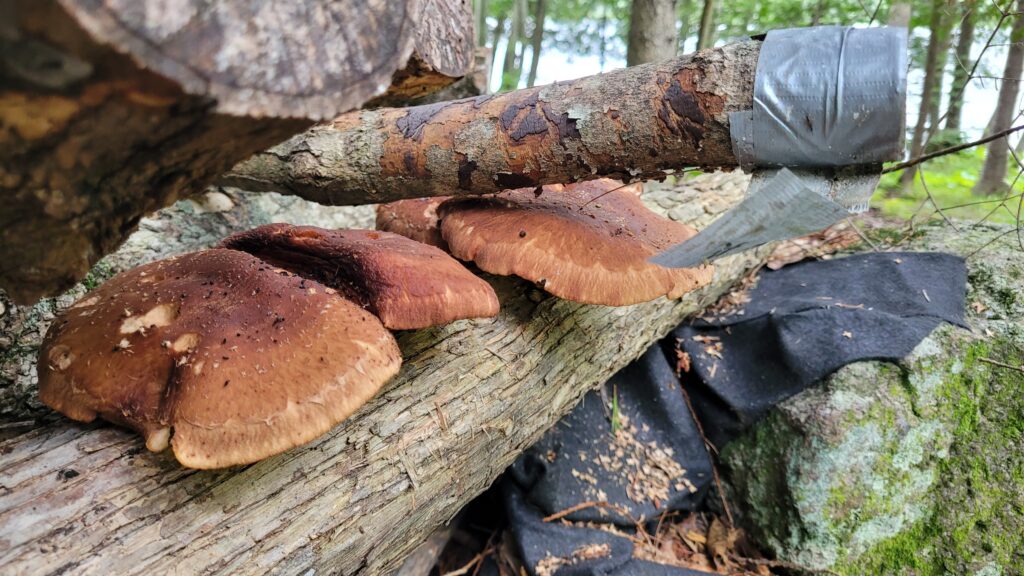
The easiest mushrooms to grow for beginners are oyster and shiitake mushrooms.
Lion’s mane and chestnut mushrooms are for intermediate growers.
Any of these can be grown with a simple bag of spawn—grain for indoors, and sawdust or plug spawn for outdoor cultivation. Qualityspawn is the current coupon for a discount.
See: 4 Fail-Proof Mushrooms to Grow Outside
Maitake, chicken of the woods, morels, and pioppino mushrooms all require extra attention for success and are best reserved for people open to experimenting with their time! Chanterelle mushrooms are best foraged, and can only be encouraged to grow in a similar environment to where they would choose to grow.
Which mushroom has the strongest flavor?
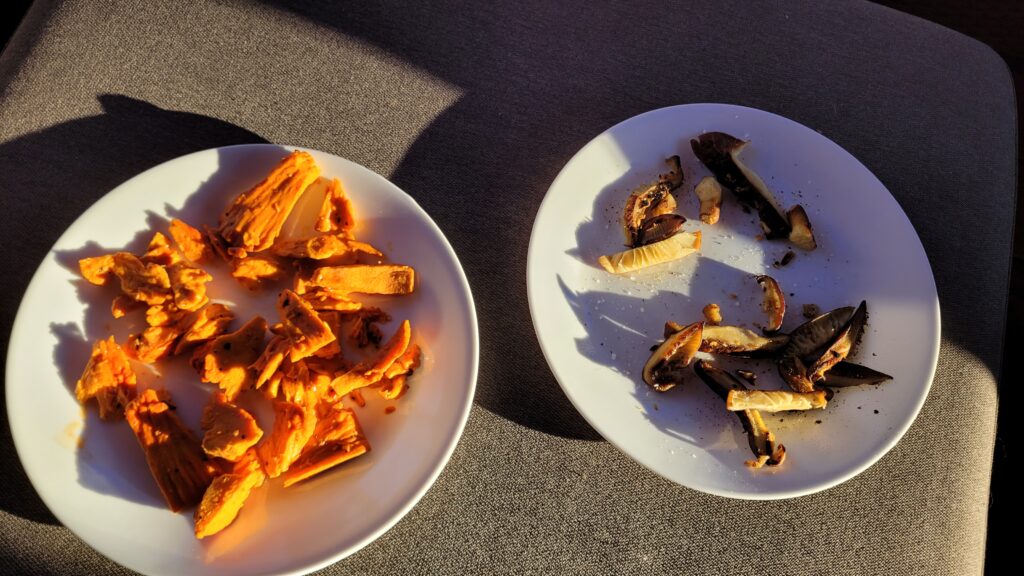
Flavor intensity can be measured by studying the concentration of various compounds contained in a mushroom!
The 5 basic flavors are sweet, salty, sour, bitter, and umami. Multiple mushrooms were studied over a decade for their umami flavor content and potency.
Turns out, this study demonstrates people’s anecdotes with accuracy! Everyone seems to describe lion’s mane as a versatile mushroom due to its mild taste. As we can see, it’s at the bottom of the chart (below) with a 3% equivalent umami concentration.
Commercial button mushrooms have the highest (strongest) concentration of umami flavor. In general, shiitake, pioppino, and oyster are described as the most flavorful gourmet mushrooms.
Based on the concentration of compounds in each mushroom, a 10-year study in Taiwan confirms popular anecdotes to be accurate.
The chart below details the percent of “equivalent umami concentration” of each mushroom.
“An EUC value of 100% indicates
The Umami Taste of Edible and Medicinal Mushrooms
that the umami intensity of fruit bodies
per 1 g dry matter is equivalent to the umami in-
tensity given by 1 g of MSG—in other words, 1 g
MSG/g dry matter.”
| Common Name | Scientific Name | EUC % Dry |
| Button mushrooms | Agaricus bisporus | 1144 |
| Gold oyster | Pleurotus citrinopileatus | 511 |
| Almond mushroom | Agaricus blazeipioppino | 136 |
| Shiitake | Lentinus edodes | 132 |
| Shaggy mane | Coprinus comatus | 103 |
| Pioppino: yellow, white, gold, brown | Agrocybe cylindracea | 46.7, 68.1, 100, 164 |
| King trumpet (big-small fruit body) | Pleurotus eryngi | 68-97.9 |
| Pearl oyster | Pleurotus ostreatus | 48 |
| Hen of the woods, maitake | Grifola frondosa | 12.7 |
| Porcini | Boletus edulis | 10.5 |
| Reishi | Ganoderma lucidum | 7.92 |
| Turkey tail | Trametes versicolor | 7.70 |
| Lion’s mane | Hericium erinaceus | 3 |
Personally, I have found shiitake mushrooms to be significantly more flavorful compared to most other “gourmet” types such as maitake, lion’s mane, white oysters, and turkey tail.
Chris, a fellow mushroom lover and grower, says “Pioppinos are the perfect fit for the everyday need. Quick and easy to grow in dense flushes, they add that bite and flavor that store-bought mushrooms wish they had.”
Oddly, the chart demonstrates that store-bought, or button mushrooms, are the strongest in flavor. Yet Chris says pioppinos have a more pronounced taste. Perhaps it’s because we are all so used to button mushrooms, a change in taste is easier to recognize.
What is the meatiest-tasting mushroom?
The ways mushrooms can resemble other foods, such as meats, are determined by anecdotes and popular opinions.
Anyone using mushrooms to imitate meat will be wondering which has the meatiest texture—since the taste can always be adjusted!
The meatiest mushrooms are maitake, chicken of the woods, lion’s mane, and shiitake. These are the most popular species used to imitate meat as they are thick, juicy, and chewy!
Each of these mushrooms resembles various types of meat.
What mushroom tastes most like chicken?
If you’re specifically looking for a chicken substitute, then look no further.
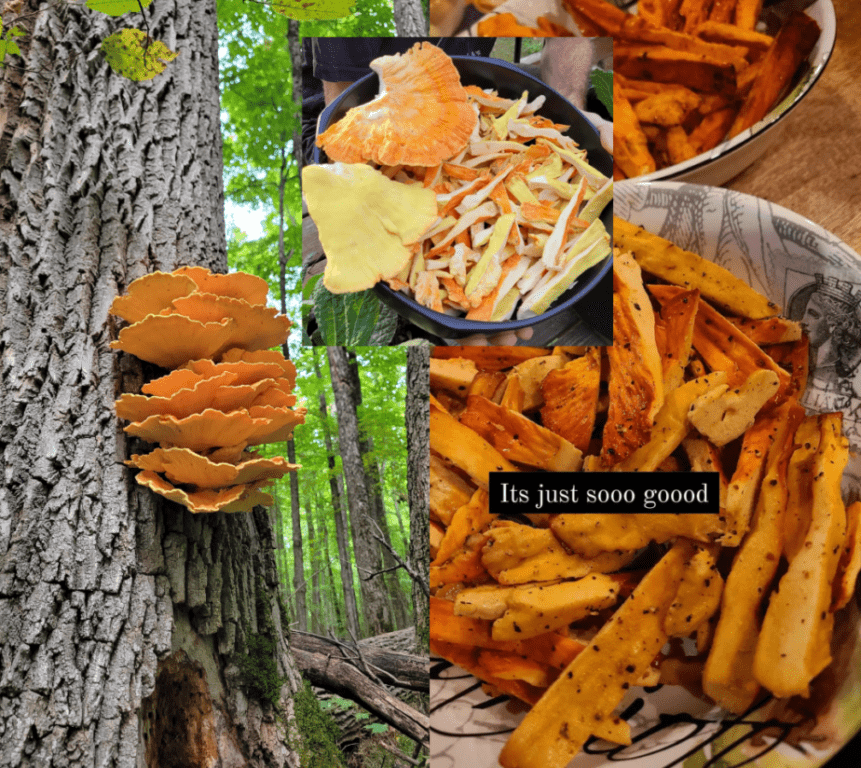
Chicken of the Woods tastes the most like white chicken meat, and Hen of the Woods (maitake) tastes the most like the brown meat of chicken. Both are equally juicy but Chicken of the Woods is thicker, dryer, and tougher. Maitake is meaty, chewy, and tender with a ‘pull.’
The way Chicken of the Woods breaks apart with each bite is impressively similar to white chicken meat. Its distinct ‘chewiness’ is, however, different.
Sauteed in a pan with salt and pepper, the texture and juiciness resemble chicken like no other mushroom, especially the thin outer edges. The tougher and thicker middle resembles “dry” chicken in texture but is still delicious (and juicy at the same time).
Maitake (hen of the woods) also has a similar ‘pull’ as chicken meat does, but more tender, like the brown meat of a bird.
Pink oyster mushrooms, however, have been anonymously described as tasting like fried chicken skin.
Which mushroom tastes the most like steak?
At a barbecue, gourmet mushrooms can make great steak substitutes for achieving a similar flavor and texture. We’ve cooked several mushrooms on a barbecue and know which tastes like what.
Chestnut bolete, lion’s mane, maitake, and shiitake mushrooms taste most like steak or beef. With a bit of olive oil, steak seasoning, and a quick cook on a barbecue, their thick meaty texture can pass as a light “steak” or a “burger” patty, and in a pan, pass as “beef” in a stir-fry.

Mushroom hunters, growers, my in-laws, and ourselves all seem to agree that the lion’s mane is highly versatile. It has a mild flavor that can taste however you wish to make it, and a texture that resembles many forms of meat.
Mushroom grower, Ty, says “oysters are good, but my favorite is lions mane. . .You’ll have to play around with heat and time depending on size, but it is soooo good! Meaty and tastes a lot like steak!“
Maitake and shiitake share an earthy flavor. Their umami taste complements most types of cuisines in different ways. on a barbecue, they can also resemble steak in texture and flavor when seasoned.
We’ve tried wine cap mushrooms on the barbecue as well, they taste great too, but are very soft and not so “meaty.” Wine caps are also dark in flavor, as is their color.
Personally, we haven’t tried chestnut bolete mushrooms, but others have said its texture and taste are just like a steak. These mushrooms are often foraged, rather than cultivated.
What mushroom tastes like fish?
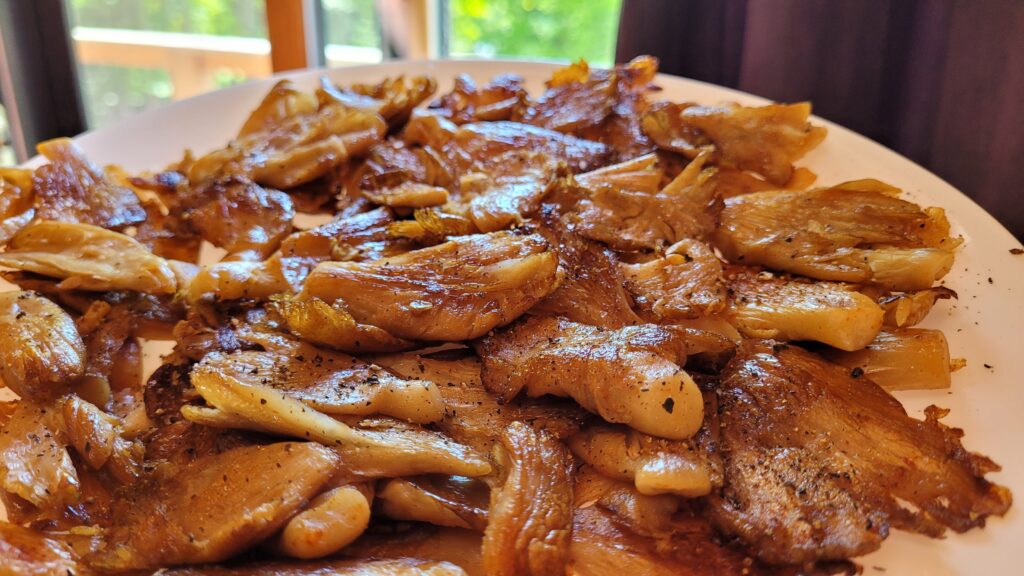
Most fish have that sea-water taste and smell. But gourmet mushrooms don’t grow and live in seawater, so you won’t find ‘fishy’ fungus.
You will find mushrooms that resemble the texture of many consumable sea creatures. Especially when cooked in certain ways.
Lion’s mane and oyster are the most fish-like mushrooms. Most mushroom lovers describe each of these species as resembling clams, crabs, fish, and seafood in general. Having tasted both lion’s mane and several types of oyster mushrooms ourselves, we certainly agree!
As I and others have said, lion’s mane mushroom is highly versatile—boil them in a soup and they resemble seafood, too!
Jack loves Lion’s Mane. “It tastes to me like clams. Lots of folks think crab or lobster. Take a New England clam chowder recipe and replace the clams with the mushroom fried in butter and garlic until golden brown.”
Mushroom grower, Bradley, says his favorite mushroom is also “Lion’s mane. Sauteed with butter and plenty of garlic. It really is very similar to king crab.”
Chris and I think pearl oysters resemble fish as they have a fleshy texture. We add chopped strips of sauteed oyster mushrooms to rice noodle soups and find it to be similar to crab.
9 Best-Tasting Mushrooms to Grow and What They’re Like
Mushrooms are popular as flavor enhancers among most cultures and sometimes end up the star of a meal. As a result, many tasty types are cultivated for consistent harvests.
Some delicious mushrooms are quite easy to grow, while others are nearly impossible. I’ll take you from the easiest edible mushrooms to grow to the most challenging varieties.
From there, you’ll know which ones are best for you to begin cultivating, and which to experiment with as you gain experience.
Growing flavorful mushrooms at home not only introduces health benefits but results in frequent mouth-watering experiences at the dinner table.
So I hope you’ll look at growing at least one of these delicious mushrooms!
Tastiest beginner mushrooms to grow
Of all the easiest mushrooms to grow oysters and shiitakes are favored the most for their flavor, texture, and versatility.
Let’s compare:
Oyster Mushroom (Pleurotus spp.)
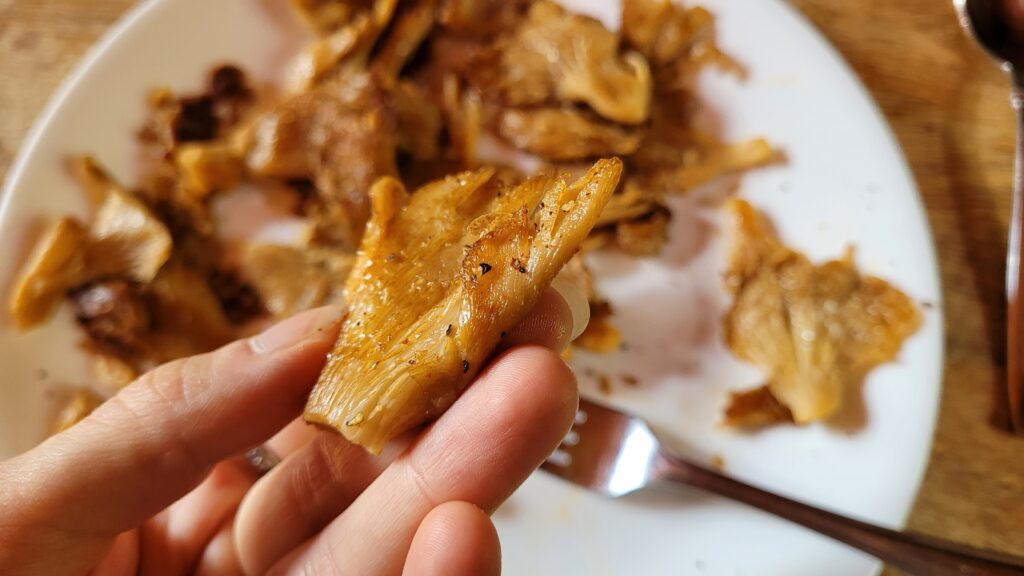
- Flavor profile: Delicate, mild, and slightly sweet
- Texture: Smooth and tender
- Growing ease: Aggressive and competitive, easy to cultivate in or outside in bags, bins, buckets, beds, or logs.
- Culinary uses: Versatile and suitable for various dishes, noodles, stir fry, pasta, and more
We enjoy pearl oysters in noodles or sauteed with garlic.
Paul, a mushroom grower likes it sauteed. He says, “I like crispy sautéed pink oyster… tastes like country ham.“
Will, a grower, says, “Oysters are great in stir fry, I love to mix it with shrimp. I usually saute in butter or olive oil to get nice crispy edges”
Hullet, a mushroom hunter, says, “crispy fried oysters with swiss cheese in an omelette. The best!”
Shiitake Mushroom (Lentinula edodes)

- Flavor profile: Savory, rich, and meaty with umami notes
- Texture: Firm and chewy
- Cultivation basics: Shiitake mushrooms grow best on logs outdoors
- Culinary significance: A staple in Asian cuisine and traditional medicine
Shiitakes didn’t seem to be a popular crowd ‘number 1’ favorite, but we love them too much to exclude them from this list. The firm, thick, and meaty texture is wonderful and they don’t become ‘nothing’ after cooking.
Tastiest intermediate mushrooms to grow
Once you’ve successfully grown easy mushrooms you’ll be excited to expand your pallet with some intermediate species!
Intermediate-level mushrooms are less aggressive than easy ones, however, they still grow well for most even beginner growers if all steps of the process are followed.
Related: How to Identify & Select Trees for Mushroom Logs (With Pics)
Lion’s Mane Mushroom (Hericium erinaceus)
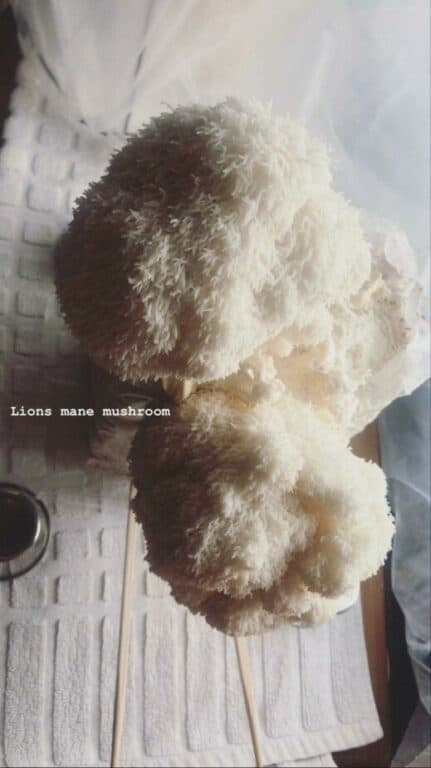
Indoor mushroom growers generally find lion’s mane to be an easy grower. Lion’s mane is described as “fast, big, and reliable” by indoor growers.
For outdoor cultivation, however, lion’s mane is best inoculated on a suitable wood type, healthy wood, and fresh wood. An optimal location also contributes to successful outdoor cultivation and passive yields.
- Flavor profile: Seafood-like with hints of sweetness and umami savory notes
- Texture: Tender, spongy, hearty, and soft
- Cultivation challenges: Grow indoors with Grain spawn or outdoors on logs with Plug spawn (use QUALITYSPAWN for a discount)
- Culinary versatility: Unique and excellent substitute for seafood or burgers
Chestnut Mushroom (Pholiota adiposa)

- Flavor profile: Rich, nutty (hence the name), and slightly sweet
- Texture: Firm, crunchy, and meaty
- Ideal growing conditions: Prefer cooler temperatures and maintained humidity to fully fruit
- Culinary uses: A gourmet treat in various culinary creations including ramen and creamy sauces
Jess says “I love chestnuts! They’re such a gorgeous color, and so pretty with their little scales. They’re like little fairy forest mushrooms! I love them cooked hot and fast in a pan with a little butter, then tumbled into an omelet with fresh herbs. Yum! They are the BEST! Very different from oysters in flavor and texture. They are quite earthy and best picked once the caps have just popped open as they hold their shape better during cooking. As with most mushrooms, the older they get the stronger in flavor they are, but where oysters can get tough when older, the caps on these guys become mushier, whilst the stalk becomes tough. If you cook them with cream they lend a gorgeous warm chestnut colour to the sauce!“
Doug says “Italian Oysters in particular, but most oysters I’ve liked a lot. Chestnut mushrooms are my absolute favorite. I like them many ways, in ramen they shine though. I add dried chestnut mushrooms to cold water that I put on the stove for my ramen. By the time they soak and heat to boiling and boil 3 mins or so they are rehydrated and add a nice texture & flavor.”
Tastiest advanced mushrooms to grow
Advanced-level mushrooms are the most difficult to grow as they are more easily overtaken by aggressive competition or require more specific conditions for fruiting.
Controlled environments make it easiest to grow advanced mushrooms, but the right climate will also yield seasonal results.
Each mushroom below is listed in order from advanced to most advanced.
Maitake (Hens of the Woods)
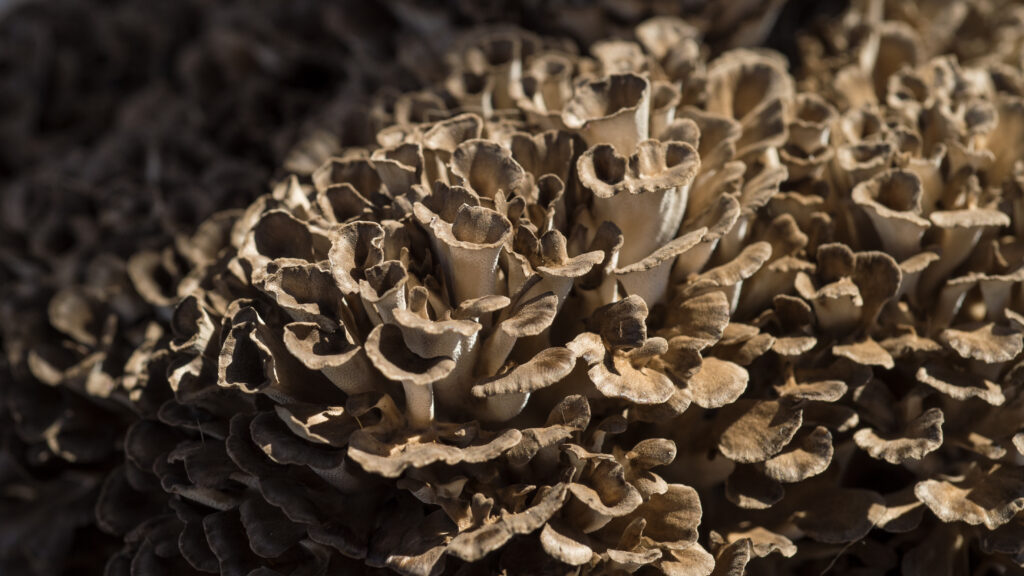
- Flavor profile: Earthy, rich, and complex
- Texture: Soft, feathery, and tender
- Cultivation tips: Maitake is easier to grow in an indoor environment with less competition. Outdoor cultivation is difficult as extra steps are required for success such as sterilizing logs and colonizing them in bags.
- Culinary significance: Delicious in everything, every way.
Chicken of the Woods (Laetiporus spp.)
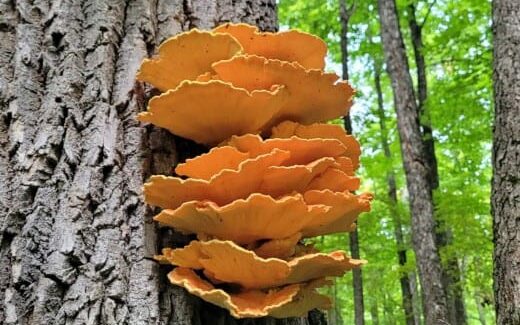
- Flavor profile: Savory and chicken-like
- Texture: Tender and fibrous, moist and dry
- Special growing considerations: Needs suitable substrates and ideal conditions like maitake
- Culinary versatility: Great sauteed with salt and pepper, and tossed in Frank’s hot sauce for “hot wings.” An exciting meat substitute in vegetarian dishes. A mushroom enjoyed by some non-mushroom lovers.
Pioppino (Agrocybe aegerita)
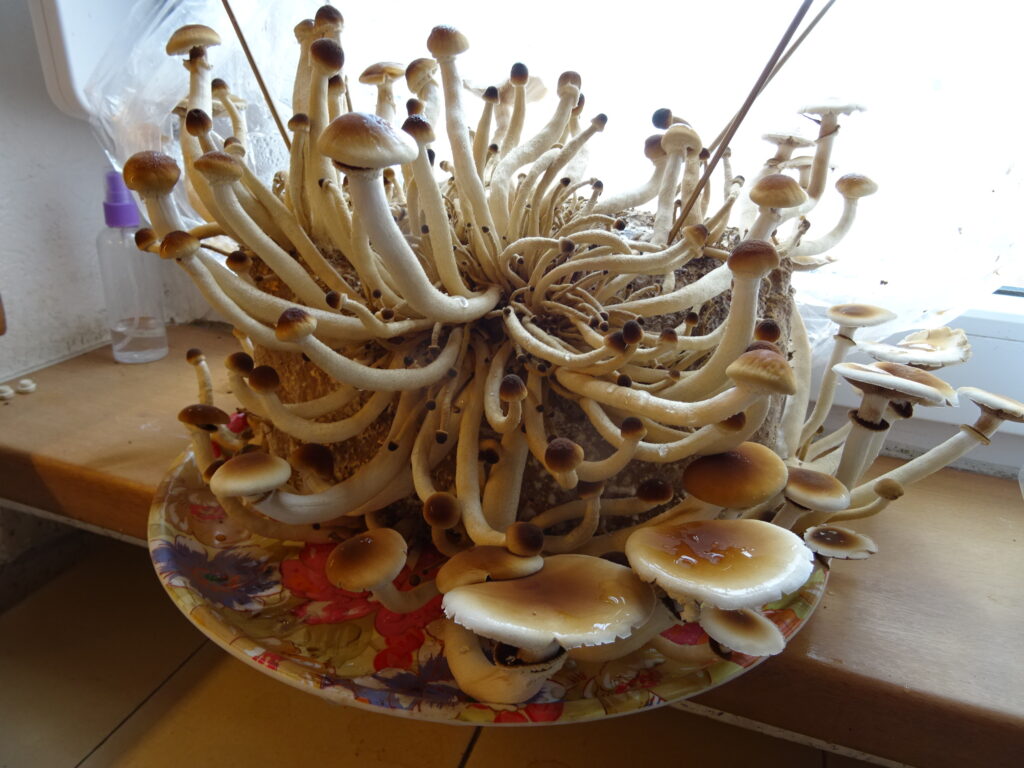
- Flavor profile: Nutty with a hint of almond
- Texture: Tender and chewy, velvety
- Cultivation techniques: Requires controlled conditions for fruiting, fast at colonizing
- Culinary uses: A favorite flavorful mushroom by most who have grown this species
Morel (Morchella)

- Flavor profile: Mild, woodsy, and nutty
- Texture: Tenderly meaty, melts in the mouth
- Cultivation techniques: Cultivation is experimental and results vary.
- Culinary uses: Sauteed alone, with vegetables, and a topping on soups, specialty bread, pizzas, and pasta
Chanterelle (Cantharellus spp.)
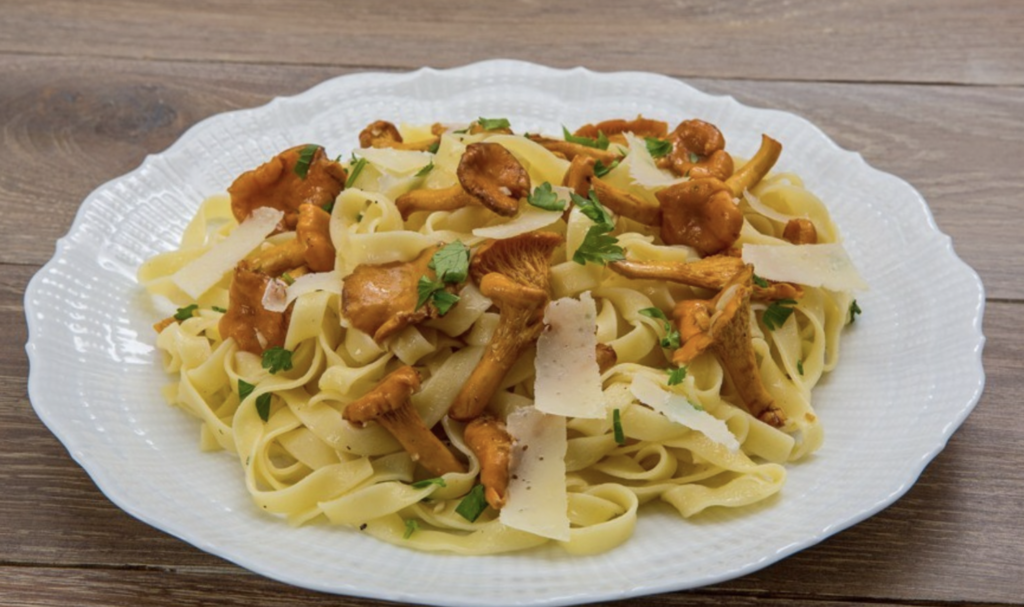
Chanterelle mushrooms can’t technically be cultivated. They can only be encouraged to grow in an environment that is inherently similar to where they choose to grow naturally.
- Flavor profile: Fruity with apricot-like notes but not sweet
- Texture: Firm, tender, and meaty
- Outdoor cultivation tips: Cultivation is only possible if introduced to an ideal naturally occurring environment
- Culinary value: Highly sought-after gourmet delicacy, one of the most popular favorites, used in pasta, stir-fry, sauces, and as toppings
Jeffrey, a mushroom hunter, says “Cinnabar Chanterelle, they keep their color and texture and flavor even though they are small. Cook them with eggs, garlic, and sage.”
Conclusion
Each tasty mushroom has its unique characteristics and everyone cooks them into their favorite meals or various types.
Mushroom cultivation is a rewarding experience, especially when it comes time to eat! Most of these gourmet mushrooms can be grown indoors and outdoors.
See:
Recent Posts
There’s no shortage of full-sun ground covers for zone 4 climates! Each plant in this list can withstand the frigid temperatures and also enjoy the hot sun in summer. Full sun means that a plant...
There's no shortage of full sun ground covers, not even in zone 3! Zone 3 climates offer hot but short-lived summers and very cold winters. So each plant in this list can withstand the frigid...
